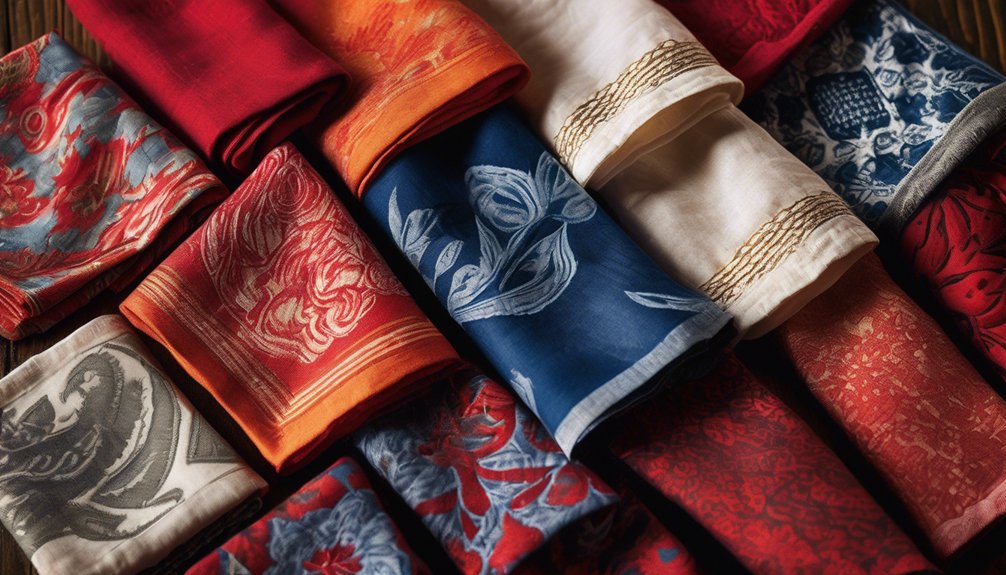Handkerchiefs and History: The Origins of the Hanky Code


Table of Contents
ToggleImagine a secret world where a simple handkerchief holds the power to reveal hidden desires and identities. That world existed in the LGBTQ community, where the hanky code emerged as a clever way to communicate safely about sexual preferences. It was a vibrant language of colors, each with its unique meaning. Curious about how this colorful code began and evolved over time? There’s so much more to uncover in this fascinating tale.
When the LGBTQ community faced significant challenges due to the criminalization of homosexuality, flagging emerged as a clever and discreet way to communicate identity and interest.
As you can observe, during this time, expressing one’s sexual orientation openly was dangerous. Flagging allowed individuals to signal to others without saying a word. This practice carried historical significance as it reflected the community’s resilience and creativity in finding safe ways to connect.
Flagging was a creative, silent signal of connection and resilience during dangerous times for expressing identity.
The use of different colored handkerchiefs and accessories became a form of cultural symbolism, representing a range of identities and preferences. It wasn’t merely about attraction; it was about building a sense of belonging and solidarity.
Flagging transformed into a powerful silent language, bridging gaps and fostering unity amid adversity.

As you investigate the vibrant world of the hanky code, you’ll find that these colorful pieces of fabric tell stories far beyond their hues. Each hanky carries a symbolism, acting as a silent communicator of identity and preferences.
Understanding the color meanings is key to maneuvering through this lively language. For instance, a black hanky might suggest dominance, while a light blue one hints at a love for conversation. Every color and shade holds specific significance, offering a glimpse into individual tastes and desires.
As you delve further, you’ll see how these symbols create connections and foster understanding within the LGBTQ community. Embrace the vibrant tapestry of hanky symbolism, and you’ll uncover a unique form of expression that transcends words.

While the origins of flagging were rooted in necessity and discretion, today it’s a vibrant form of self-expression and community building. You can see flagging trends evolving, reflecting broader cultural shifts and modern adaptations.
Now, it’s common to use a variety of accessories, not just handkerchiefs, to communicate one’s identity and interests. This practice welcomes creativity, allowing you to investigate and express who you’re in an inclusive environment.
Modern adaptations have expanded beyond traditional meanings, incorporating new colors and symbols that represent diverse identities. As you navigate today’s flagging scene, you’ll notice how it fosters connections and celebrates individuality.
Whether at pride events or in everyday life, flagging continues to be a dynamic way to engage with the LGBTQ community.
To craft your unique flagging identity, start by exploring the colors and symbols that resonate with you personally. Think about what aspects of yourself you’d like to express and how these can be represented through your choices.
Personal expression is key, so don’t be afraid to experiment with different hues and patterns.
Next, consider accessory customization. Visit craft stores or online platforms to find materials that suit your taste.
Whether it’s a handkerchief, scarf, or another item, personalize it to reflect your style. Add unique touches like embroidery or patches to make your flag truly yours.
Even when Pride Month has come and gone, supporting LGBTQ causes remains vital. You can engage in year-round advocacy by staying active in community outreach. This means joining local LGBTQ groups or volunteering at events beyond June. Your involvement helps create safe spaces and strengthens community bonds.
Consider donating to organizations like The Trevor Project or Rainbow Railroad, which work tirelessly year-round. Your contributions provide critical support to those in need.
Additionally, educate others about LGBTQ issues by sharing resources and personal stories. This raises awareness and inspires positive change.
Imagine the initial confusion of law enforcement when they originally noticed the colorful hankies fluttering in pockets.
Their initial reactions were a mix of curiosity and suspicion. Officers tried to decode this secretive system, unsure whether it was harmless or hiding something illicit.
As they became aware of the hanky code‘s purpose, they adapted their approach, sometimes leading to changes in the color and pattern choices within the community.
You might be surprised to learn that flagging, beyond its LGBTQ roots, can also serve non-LGBTQ purposes.
People use fashion accessories like scarves or bandanas for cultural signaling, indicating affiliation or interests within diverse subcultures, such as music festivals or sports teams.
When you wear a specific color or pattern, it can express your style or group identity, making it a versatile tool for personal expression across different communities.
Flagging transformed LGBTQ nightlife by enriching social interactions and shaping the nightlife culture.
You’d find it easier to connect with others, using handkerchiefs to express interests and identities discreetly. This colorful system allowed you to navigate spaces with confidence, fostering a sense of belonging and community.
Flagging became a vibrant part of nightlife, encouraging openness and dialogue among individuals, making venues more inclusive and lively for everyone involved.
Flagging spread internationally through cultural exchange as travelers and the global LGBTQ community shared ideas and practices.
You’d see how people adapted the code to fit their local contexts, creating a global adaptation of this unique form of expression.
With the rise of international events and online platforms, flagging became a vibrant way to connect across borders, making it easier for you to understand and participate in this colorful tradition worldwide.
You can definitely use digital flagging in online communities!
It’s a modern twist on traditional flagging, allowing you to express identity and preferences through social media profiles, emojis, or digital badges.
In forums or apps, you can creatively display your interests and connect with like-minded individuals.
Just like physical flagging, digital flagging helps foster community and understanding, making it a vibrant part of online LGBTQ spaces today.
You’ve investigated how hankies became a secret language of connection in the LGBTQ community. Coincidentally, as society becomes more open, this colorful code still speaks volumes about identity and pride. You realize that whether you’re waving a flag or wearing a hanky, you’re part of a vibrant tapestry that’s both historical and modern. By supporting LGBTQ causes beyond just Pride Month, you’re not just showing off colors—you’re adding to an ongoing story of resilience and unity.
 Featured PostsNovember 5, 2025Changing Bodies, Changing Desires: Sex Identity in Transition
Featured PostsNovember 5, 2025Changing Bodies, Changing Desires: Sex Identity in Transition Featured PostsNovember 4, 2025Passing Tips Every Trans Girl Should Know
Featured PostsNovember 4, 2025Passing Tips Every Trans Girl Should Know Featured PostsNovember 4, 2025Trans 101: The Facts Everyone Should Know
Featured PostsNovember 4, 2025Trans 101: The Facts Everyone Should Know Featured PostsNovember 4, 2025Beyond the Basics: An In-Depth Preparation Roadmap for Your Facial Feminization Surgery Consultation
Featured PostsNovember 4, 2025Beyond the Basics: An In-Depth Preparation Roadmap for Your Facial Feminization Surgery Consultation